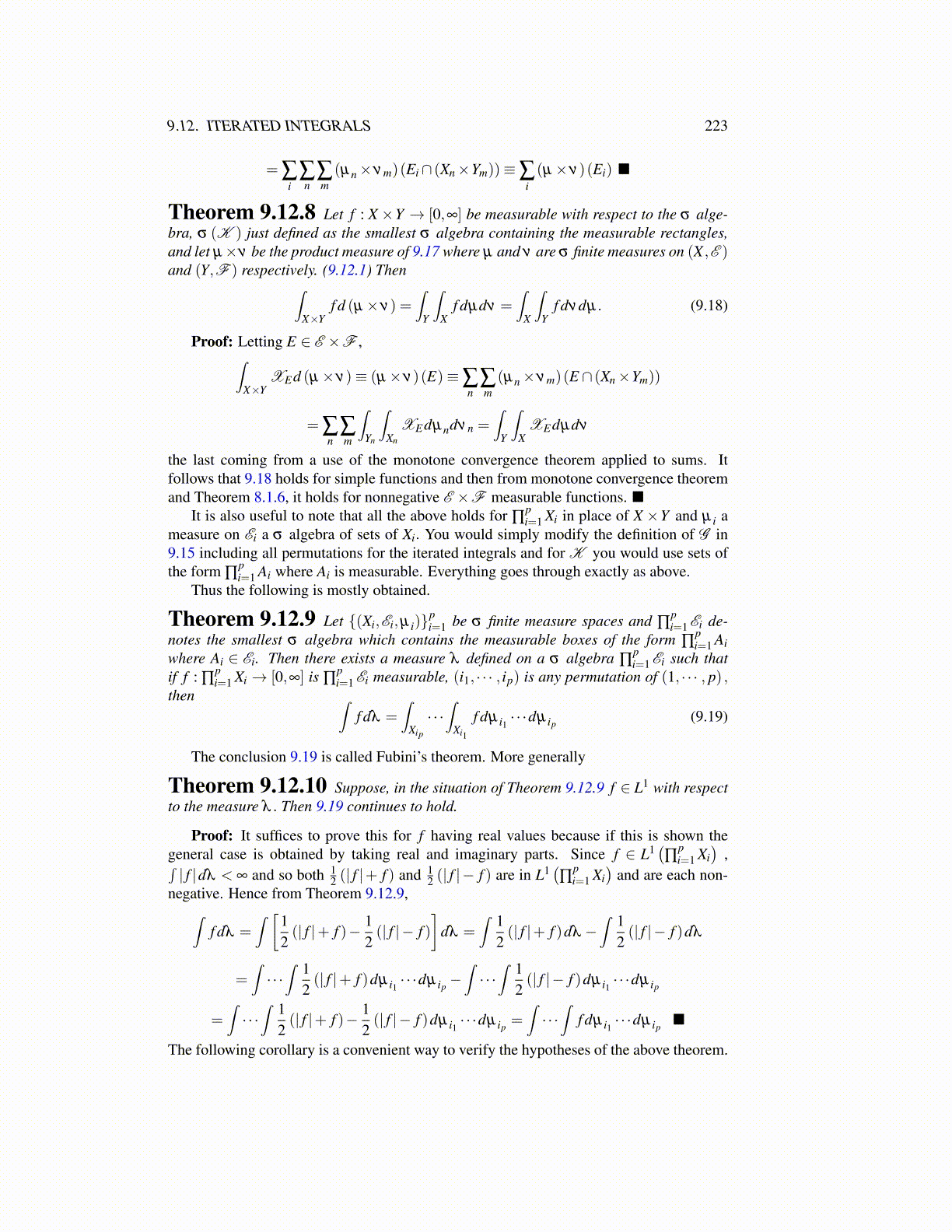
9.12. ITERATED INTEGRALS 223
= ∑i
∑n
∑m(µn×νm)(Ei∩ (Xn×Ym))≡∑
i(µ×ν)(Ei) ■
Theorem 9.12.8 Let f : X ×Y → [0,∞] be measurable with respect to the σ alge-bra, σ (K ) just defined as the smallest σ algebra containing the measurable rectangles,and let µ×ν be the product measure of 9.17 where µ and ν are σ finite measures on (X ,E )and (Y,F ) respectively. (9.12.1) Then∫
X×Yf d (µ×ν) =
∫Y
∫X
f dµdν =∫
X
∫Y
f dνdµ. (9.18)
Proof: Letting E ∈ E ×F ,∫X×Y
XEd (µ×ν)≡ (µ×ν)(E)≡∑n
∑m(µn×νm)(E ∩ (Xn×Ym))
= ∑n
∑m
∫Yn
∫Xn
XEdµndνn =∫
Y
∫X
XEdµdν
the last coming from a use of the monotone convergence theorem applied to sums. Itfollows that 9.18 holds for simple functions and then from monotone convergence theoremand Theorem 8.1.6, it holds for nonnegative E ×F measurable functions. ■
It is also useful to note that all the above holds for ∏pi=1 Xi in place of X ×Y and µ i a
measure on Ei a σ algebra of sets of Xi. You would simply modify the definition of G in9.15 including all permutations for the iterated integrals and for K you would use sets ofthe form ∏
pi=1 Ai where Ai is measurable. Everything goes through exactly as above.
Thus the following is mostly obtained.
Theorem 9.12.9 Let {(Xi,Ei,µ i)}pi=1 be σ finite measure spaces and ∏
pi=1 Ei de-
notes the smallest σ algebra which contains the measurable boxes of the form ∏pi=1 Ai
where Ai ∈ Ei. Then there exists a measure λ defined on a σ algebra ∏pi=1 Ei such that
if f : ∏pi=1 Xi → [0,∞] is ∏
pi=1 Ei measurable, (i1, · · · , ip) is any permutation of (1, · · · , p) ,
then ∫f dλ =
∫Xip
· · ·∫
Xi1
f dµ i1 · · ·dµ ip(9.19)
The conclusion 9.19 is called Fubini’s theorem. More generally
Theorem 9.12.10 Suppose, in the situation of Theorem 9.12.9 f ∈ L1 with respectto the measure λ . Then 9.19 continues to hold.
Proof: It suffices to prove this for f having real values because if this is shown thegeneral case is obtained by taking real and imaginary parts. Since f ∈ L1
(∏
pi=1 Xi
),∫
| f |dλ < ∞ and so both 12 (| f |+ f ) and 1
2 (| f |− f ) are in L1(∏
pi=1 Xi
)and are each non-
negative. Hence from Theorem 9.12.9,∫f dλ =
∫ [12(| f |+ f )− 1
2(| f |− f )
]dλ =
∫ 12(| f |+ f )dλ −
∫ 12(| f |− f )dλ
=∫· · ·∫ 1
2(| f |+ f )dµ i1 · · ·dµ ip
−∫· · ·∫ 1
2(| f |− f )dµ i1 · · ·dµ ip
=∫· · ·∫ 1
2(| f |+ f )− 1
2(| f |− f )dµ i1 · · ·dµ ip
=∫· · ·∫
f dµ i1 · · ·dµ ip■
The following corollary is a convenient way to verify the hypotheses of the above theorem.